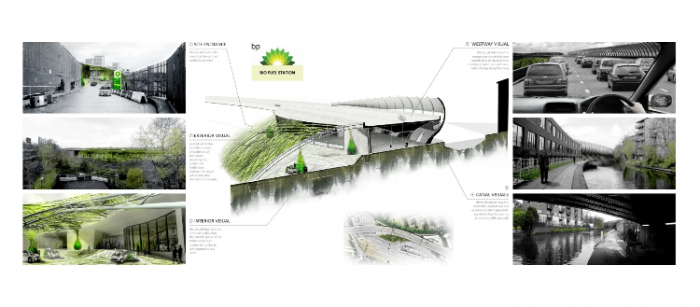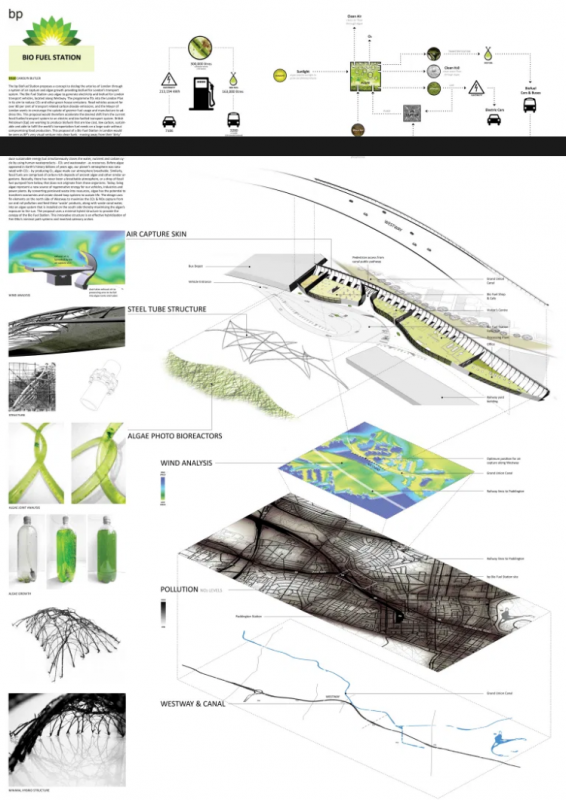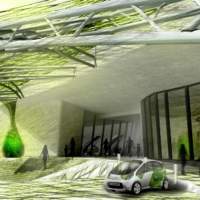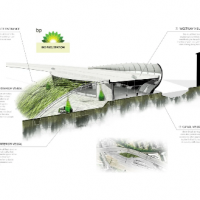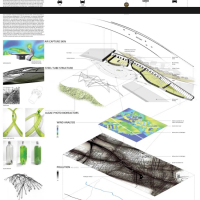bp BioFuel Station by Carolyn Butler
The bp BioFuel Station proposes a concept to the arteries of London through a system of air capture and algae growth providing bio fuel for London’s transport system. The Bio Fuel Station uses algae to generate electricity and biofuel for London transport vehicles, located along West way. The program fits into the London Plan in its aim to reduce CO2 and other green house emissions. Road vehicles account for over 80 per cent of transport related carbon dioxide emissions, and the Mayor of London wants to encourage the uptake of greener fuel usage and manufacture to address this. This proposal would therefore accelerate the desired shift from the current fossil fuelled transport system to an electric and bio-fuelled transport system. British Petroleum [bp] are working to produce bio fuels that are low cost, low carbon, sustainable and able to fulfil the world’s transportation fuel needs on a large scale without compromising food production. This proposal of a Bio Fuel Station in London would be seen as BP’s very visual venture into clean fuels – moving away from their ‘dirty’ image, branded courtesy of Greenpeace. The project would highlight BP’s sustainable agenda and start to re-direct their reputation down a greener path literally and metaphorically.
This project will utilise an algae based system that not only provides a method to produce sustainable energy but simultaneously closes the water, nutrient and carbon cycle by using human wasteproducts – CO2 and wastewater – as resources. Before algae appeared in Earth’s history billions of years ago, our planet’s atmosphere was saturated with CO2 – by producing O2, algae made our atmosphere breathable. Similarly, fossil fuels are comprised of carbon-rich deposits of ancient algae and other similar organisms. Basically, there has never been a breathable atmosphere, or a drop of fossil fuel pumped from below, that does not originate from these organisms. Today, living algae represent a new source of regenerative energy for our vehicles, industries and power plants. By converting perceived waste into resources, algae has the potential to transform economies and create closed loop systems to sustain life. The design uses fin elements on the north side of Westway to maximise the CO2 & NOx capture from car and rail pollution and feed these ‘waste’ products, along with waste canal water, into an algae system that is installed on the south side thereby maximising the algae’s exposure to the sun. The proposal uses a minimal hybrid structure to provide the canopy of the Bio Fuel Station. This innovative structure is an effective hybridization of Frei Otto’s minimal path systems and inverted catenary arches.
Credits :
Student: Carolyn Butler
Diploma Studio 10 at Westminster University School of Architecture and the Built Environment
Tutors: Arthur Mamou-Mani & Toby Burgess
- Courtesy of Carolyn Butler
- Courtesy of Carolyn Butler
- Courtesy of Carolyn Butler
Courtesy of Carolyn Butler


